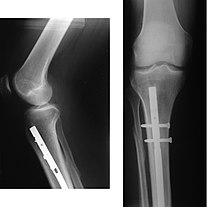Intramedullary rod
Prior to that, treatment of such fractures was limited to traction or plaster, both of which required long periods of inactivity.
[3] The oldest intramedullary nail was found in the left knee of a mummy named Usermontu, the remains of an Egyptian man from more than 3,500 years ago.
Although stainless steel was used for older IM nails, titanium has several advantages, including lower mechanical failure rates and improved biocompatibility.
[6] A more significant problem with earlier designs was their failure to prevent collapse or rotation in inherently unstable fractures.
Lower screws holding intramedullary rods can sometimes cause limited dorsiflexion as a result of damage and subsequent healing and fibrotic developments around that area.


